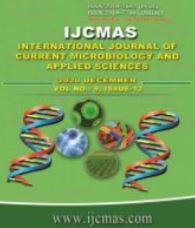


 National Academy of Agricultural Sciences (NAAS)
National Academy of Agricultural Sciences (NAAS)

|
PRINT ISSN : 2319-7692
Online ISSN : 2319-7706 Issues : 12 per year Publisher : Excellent Publishers Email : editorijcmas@gmail.com / submit@ijcmas.com Editor-in-chief: Dr.M.Prakash Index Copernicus ICV 2018: 95.39 NAAS RATING 2020: 5.38 |
A pot experiment was conducted during kharif season of 2016-17 and 2017-18 in completely randomized design with two lime levels (0 and ¼ lime of LR), four phosphorus levels (0, 13.4, 26.8 and 40.2 mg P2O5 kg-1) and three boron levels (0, 0.45 and 0.90 mg B kg-1) to study the treatment effect on nutrient content and uptake of maize and soil properties. It was observed that lime had a significant effect on biomass yield, nutrient content and uptake of maize. Application of ¼ lime of LR increased the grain yield by 25.3% and 24.0% and stover yield by 24.1% and 22.0% during first and second year, respectively over control. Effect of phosphorus was significant on the yield, nutrient content and uptake of maize, where application of 26.8 mg P2O5 kg-1 proved optimum level. Conversely, B content in both grain and stover remained unaffected by P application. Application of 26.8 mg P2O5 kg-1 increased grain yield by 23.6% and 23.0% and stover yield by 19.7% and 20.0% during first and second year, respectively over control. Application of boron had a significant effect on yield where highest grain and stover yield was recorded at 0.90 mg B kg-1 which increased grain yield by 8.7% and 13.1% and stover yield by 9.9% and 11.4% during first and second year, respectively. Significant effect of B on nutrient content was observed in N, P and B content in grain and stover, while significant effect of B on nutrient uptake was observed in N, P, K and B uptake in grain and stover. Among the soil properties, application of ¼ lime of LR significantly increased soil pH, base saturation, available N, P, K, Ca and B, while it decreased exchangeable H+, Al3+ and total potential acidity of post-harvest soil. Significant effect of P was observed on available P and exchangeable Ca of post-harvest soil, while effect of boron was significant only on the available boron of post-harvest soil.
 |
 |
 |
 |
 |